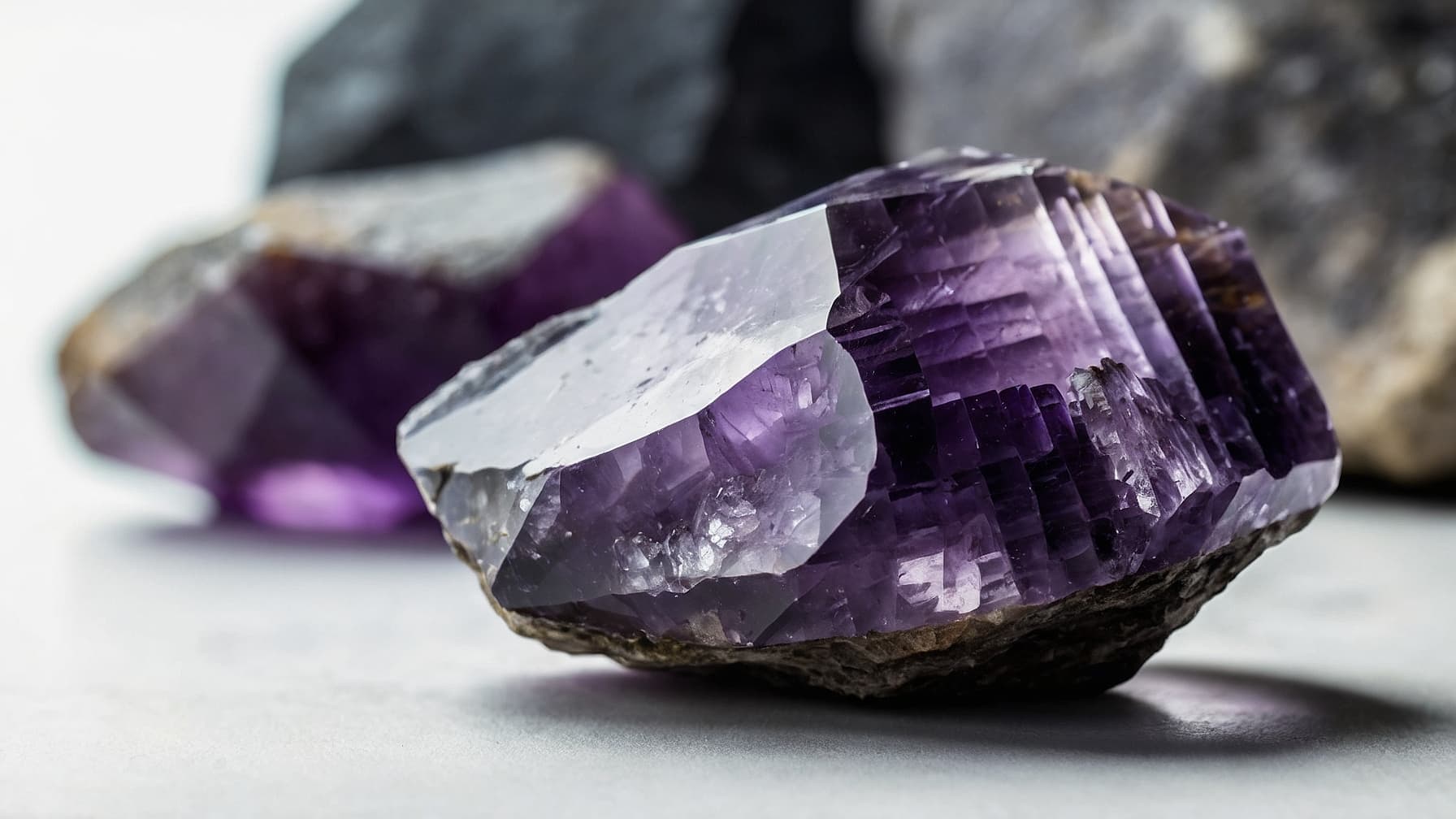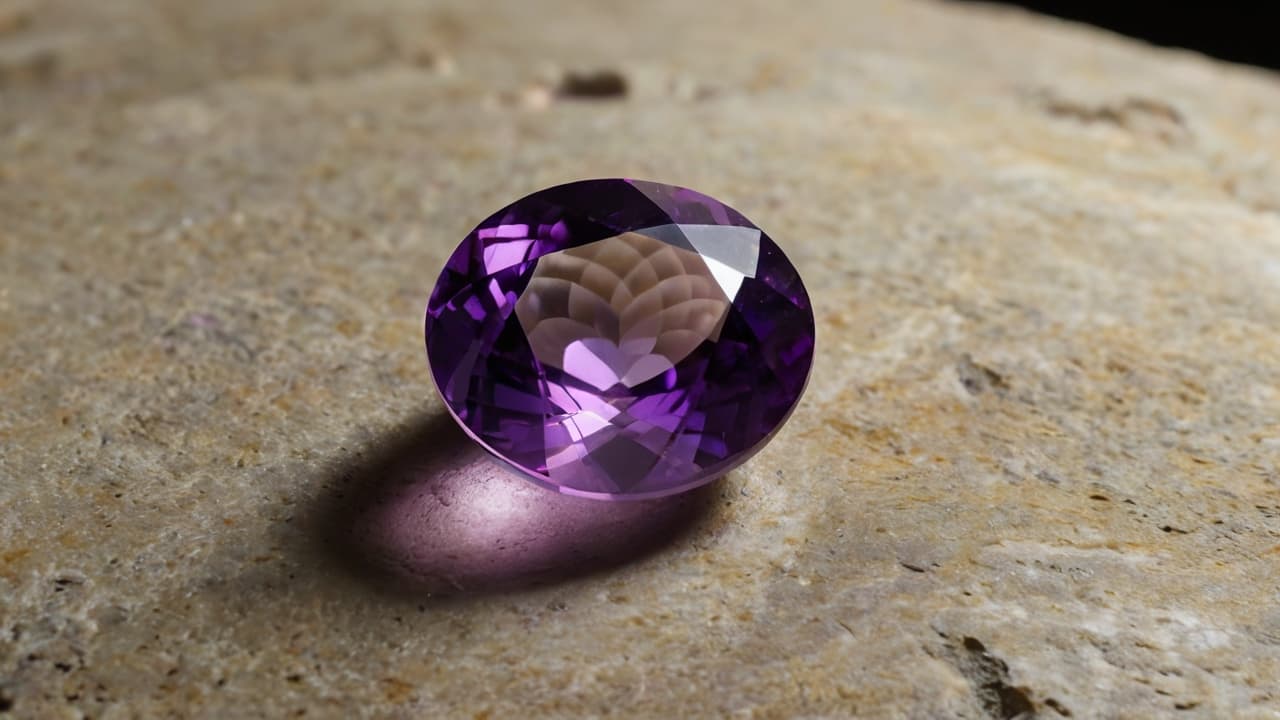About Amethyst Crystal
The Amethyst crystal is one of the most captivating natural phenomena, impressing with its unique purple color and crystalline structure.

Amethyst is the most attractive stone in the quartz group. Its distinctive purple color is due to several factors, including the small amounts of iron and manganese. These elements influence the chemical composition and crystalline structure of Amethyst, determining its color and character.
Although traditionally considered a precious stone, its significance extends beyond its aesthetic appeal. Amethyst holds a special place in the world of crystals due to its renowned healing properties and spiritual significance .
But what is Amethyst? How is this remarkable gemstone formed? Where does Amethyst come from?
Formation of Amethyst
Amethyst crystals are formed as a result of a complex geological process that begins with various natural phenomena, such as volcanic eruptions or tectonic movements. These events lead to the formation of cracks, voids, or cavities in rock formations.
Subsequently, water from various sources, such as rainfall or underground aquifers, begins to penetrate into these cracks. Along with the water, dissolved minerals, including silicon dioxide (SiO2), the main component of quartz, enter the cracks.
Over time and through chemical reactions, water begins to dissolve the surrounding minerals, especially silicon. As water flows through the cracks and conditions change, such as pressure or temperature, dissolved silicon dioxide begins to precipitate on the walls of the cracks.
This precipitated silicon dioxide gradually crystallizes, forming microscopic quartz crystals. They serve as nuclei for the further growth of crystals. The characteristic purple color of Amethyst is due to the presence of microscopic impurities of iron and manganese in the dissolved minerals.
With the passage of time and the prolonged process of deposition and crystallization, Amethyst crystals reach the characteristic shape and size that we see today. This process can take thousands or even millions of years and depends on many factors, such as environmental conditions and the composition of minerals in the cracks.
Growth Forms of Amethyst Crystals
Amethyst can take on various growth forms depending on the conditions in which it forms. The most common growth forms are:
Druzy Amethyst

Druzy Amethyst (geode) refers to tiny sparkling crystals that form a layer on a matrix, often found on the surface of larger crystals or within cavities inside rock formations. These small crystals create a shimmering effect, giving the surface a sparkling appearance.
Amethyst Scepters

Amethyst scepters are special formations where a larger crystal grows on top of a smaller crystal, resembling a scepter or wand. The smaller crystal serves as the base, and the larger crystal grows on top of it, creating a striking and often visually appealing formation.
Amethyst with Split Growth

This form of growth occurs when an Amethyst crystal is subjected to stress or disruption during its growth, resulting in a fracture or twinning. These crystals may have two distinct terminations or branches that diverge from the central point, creating a unique and sometimes asymmetrical shape.
Prismatic Amethyst with a Well-Developed Structure

Prismatic Amethyst crystals have a distinct elongated form with parallel sides and a pointed end. These crystals are often uniform in color and transparency, with clear faces along their length, giving them a classic and elegant appearance.
Chevron Amethyst

Chevron Amethyst is a variety of Amethyst characterized by banded patterns, typically alternating between shades of purple and white quartz. When this material forms in vein-like structures within rock formations, it creates stunning patterns reminiscent of chevrons or V-shaped forms, hence the name.
In addition to the widely recognized forms of Amethyst, there are two unique types that add variety and interest to this crystal:
Hairy Amethyst

Hairy amethyst consists of amethyst crystals with rutile inclusions that create the effect of thin golden or black hairs inside the crystal. These hairs can create amazing plays of light and add uniqueness and beauty to the amethyst.
Ametrine

Ametrine is a unique crystal that combines two different minerals: Amethyst and Citrine. It has a banded structure where purple and yellow hues alternate within one crystal. Ametrine forms as a result of the natural junction lines between the growth zones of Amethyst and citrine inside the quartz crystal. This creates a unique and attractive appearance, making ametrine one of the most valuable and beautiful crystals.
Amethyst Colors
Amethyst presents us with a wide range of purple hues of varying intensity, from nearly colorless pale purples to bluish-purple to deep purple, almost black. Additionally, it can have various shades of pink, red, and blue.
Although the primary color of Amethyst is purple, there are other color variations such as pink, red, black, and green (prasiolite), which are attributed to various factors influencing the mineral composition during its formation.
The color of Amethyst can be uniform throughout the crystal or have different tonal transitions and inclusions, creating interesting and unique color patterns. The most intense color is usually concentrated at the tip of the crystal, so when cutting the stone, the tips are often removed.
Typically, a more saturated color of Amethyst is associated with a higher concentration of metallic inclusions, such as iron or manganese, in its composition. Although the exact composition of Amethyst may vary depending on the specific deposit and the conditions in which it formed, the basic chemical formula remains the same.
The color of the stone can be changed. Heating to 470–750 °C leads to a change in the Amethyst color to golden-yellow - citrine, while careless heating can lead to its disappearance altogether. Some Amethysts fade in light. Upon radioactive exposure, the original color is restored.
Geological Properties of Amethyst
The physical, chemical, and optical properties define the composition, structure, and unique characteristics of Amethyst, making it one of the most popular and valuable gemstones in the jewelry world.
Chemical Properties of Amethyst
Chemical Formula: Amethyst belongs to the quartz group of minerals. The chemical formula is SiO2 (silicon dioxide). This means that each Amethyst crystal consists of silicon atoms bonded to oxygen atoms.
Hardness: Amethyst has a hardness of 7 on the Mohs scale, making it resistant to scratching.
Chemical Inertness: Amethyst is characterized by chemical inertness and typically does not react with most acids and other chemicals. However, it can be treated with hydrofluoric acid, which can dissolve silica in its crystalline structure.
Thermal Stability: Amethyst demonstrates exceptional resistance to heat and maintains its integrity even under elevated temperatures, showing no signs of melting or decomposition.
Acid Resistance: Amethyst usually does not dissolve in common acids such as hydrochloric or sulfuric acids, making it stable when in contact with them.
Physical Property of Amethyst
Crystal Structure: Amethyst has a tetrahedral crystal structure in which each silicon atom is bonded to four oxygen atoms.
Cleavage: Amethyst does not have distinct cleavage planes, so it does not break along any specific plane or direction.
Specific Gravity: The specific gravity of Amethyst varies from 2.63 to 2.65.
Color Impurities: The purple color of Amethyst is caused by the presence of microscopic impurities of iron and manganese in its crystalline lattice.
Texture: The surface of Amethyst is typically smooth or slightly textured. It may also have some irregularities and inclusions, giving the stone a unique charm.
Transparency: Most Amethysts are transparent or translucent, allowing light to pass through the stone and create beautiful effects.
Luster: Amethyst usually has a vitreous luster, which adds brightness and attractiveness to it.
Refractive Index: The refractive index of Amethyst ranges from 1.54 to 1.55, meaning that light is slightly bent when passing through the crystal.
Fluorescence: Some specimens of Amethyst exhibit fluorescent properties, emitting visible light when exposed to ultraviolet light.
Magnetism: Amethyst does not exhibit magnetic properties.
Optical Properties of Amethyst
Double Refraction: Amethyst exhibits the phenomenon of double refraction, where one beam of light is split into two when passing through the crystal. The degree of this effect depends on the orientation of the crystal.
Pleochroism: Amethyst has a weak pleochroism, meaning it has the ability to display different colors depending on the viewing angle. However, this effect is not highly pronounced in most specimens.
Dispersion: Amethyst displays minimal dispersion, causing light to scatter only slightly into its individual colors.
Optical Effects: Sometimes, optical effects such as asterism or the "cat's eye" effect can be observed in Amethyst, especially in stones with developed inclusions.
Where is Amethyst Found?
Amethyst, one of the most popular and beautiful varieties of the mineral quart, forms in various parts of the world due to complex geological processes.
This gemstone is mined worldwide, with each deposit imparting its own unique characteristics to the precious stone, varying depending on the location of extraction. Stones from different regions may exhibit different color saturations and shades of purple, as well as distinct features in internal structure and crystal forms.
Let's discover the different continents where Amethyst is found.
South America: Brazil and Uruguay
South America stands as one of the primary sources of Amethyst. Brazil, particularly the Rio Grande do Sul region, is renowned for its abundant and high-quality Amethyst deposits. The city of Ametista do Sul translates to "Amethyst of the South," highlighting the significance of this gemstone in the region. Uruguay also boasts notable Amethyst mines, with their crystals prized for their deep color and clarity.
Brazilian Amethyst typically stands out with its deep purple hue, sometimes with red or blue undertones. The crystals come in various shapes and sizes, often featuring large and crystal-clear specimens. On the other hand, Uruguayan Amethyst is prized for its deep purple color and exceptional transparency. Crystals from Uruguay often exhibit uniform color distribution and an attractive appearance.
North America: United States and Canada
In North America, the United States and Canada host significant Amethyst deposits. The state of Arizona in the U.S. is known for its Thunder Bay Amethyst, characterized by its rich purple hues. Additionally, the Canadian province of Ontario is famous for its deposits near Thunder Bay, which produce large, lustrous crystals highly sought after by collectors.
American Amethyst from Thunder Bay in Arizona usually boasts an intense purple color with vibrant flashes. Canadian Amethyst, mined in Ontario, is often characterized by large and brilliant crystals with excellent transparency. Both sources offer high-quality Amethyst, but with differences in shades and crystal sizes.
Africa: Zambia and Madagascar
Africa is another continent rich in Amethyst deposits. Zambia is renowned for its deep purple Amethyst crystals, often found alongside other gemstones in the region's copper mines. Madagascar, known for its diverse gemstone wealth, also produces Amethysts of exceptional quality. The Amethyst from Madagascar often exhibits unique inclusions and color variations, adding to its allure.
Zambian Amethyst is known for its dark purple crystals and typically has a richer hue compared to Amethyst from other regions. Malagasy Amethyst can offer a wide range of shades, from light purple to deep lavender, and also features unique inclusions and color variations.
Europe: Russia and Germany
Europe contributes to the global Amethyst supply as well. Russia, particularly the Ural Mountains region, has been a significant source of Amethyst for centuries. Russian Amethyst is prized for its deep color and transparency. Germany, with its famous Idar-Oberstein region, also has a history of Amethyst mining, although production has decreased over the years.
Russian Amethyst, mined in the Ural Mountains, usually possesses a deep purple hue with excellent transparency. German Amethyst from the Idar-Oberstein region is also known for its rich tones, although its production has decreased over the years, making it harder to find on the market.
Asia: South Korea and India
While not as prominent as on other continents, Asia also has its share of Amethyst deposits. South Korea has emerged as a notable producer of Amethyst, particularly in the Gyeonggi-do province. Indian Amethyst, found in various regions across the country, contributes to the global supply as well.
In South Korea, Amethyst often has a delicate purple hue with soft color transitions. Korean crystals may be smaller in size, but they boast exquisite transparency and clarity. Indian Amethyst, on the other hand, typically features a more saturated color and deeper shades, often with bright purple flashes. Crystals from India can have various shapes and structures, sometimes with unique inclusions.
The allure of Amethyst spans continents, with each region offering its own unique characteristics to this mesmerizing gemstone. Whether it's the deep purples of Brazil, the clarity of Canadian crystals, or the inclusions found in Madagascar's specimens, Amethyst continues to captivate gem enthusiasts worldwide.
Mining and Processing of Amethyst
Amethyst, with its captivating purple hues and mystical allure, undergoes a fascinating journey from the depths of the earth to becoming a cherished gemstone in various applications. In this exploration, we delve into the intricate processes of mining and processing that bring this crystalline marvel from its natural habitat to the hands of artisans and enthusiasts worldwide.
Mining
The extraction of Amethyst involves retrieving this crystalline mineral from its natural deposits. It can be carried out using various methods, depending on the geological features and type of deposit.
In the case of open-pit mining, the upper layers of rock and soil are removed to access the Amethyst formations located beneath them. This method is often employed when Amethyst deposits are close to the surface.
Underground mining entails the construction of tunnels and shafts deep underground to extract Amethyst from underground accumulations and veins. This method is utilized when deposits are located at significant depths.
Placer mining involves the collection of loose Amethyst crystals from placer deposits, where crystals may be scattered in soil or riverbeds. This method is often applied when Amethyst forms as individual crystals scattered in the environment.
All these methods require careful evaluation of geological conditions as well as the application of specialized tools and techniques to extract Amethyst without damage and preserve its valuable qualities.
Processing
After extraction, Amethyst undergoes several processing stages to prepare it for use in various applications, including jewelry and decorative items.
At the beginning of the process, Amethyst is cleaned of dirt, clay, and other impurities that may be present on its surface after mining.
After cleaning, Amethyst undergoes cutting, where its shape and dimensions can be adjusted according to requirements. This may include cutting crystals into cabochons, faceted crystals, or other forms.
The stones then undergo grinding and polishing to give them a smooth surface and luster. This is done using special abrasives and polishing tools.
Finally, Amethyst is sorted by quality, color, and size. It may also be calibrated to create uniform batches or jewelry sets.
This process prepares Amethyst for further use in jewelry and industrial production, as well as in decorative and artistic applications.
Cutting and Polishing of Amethyst
Cutting and polishing Amethyst is the process of transforming rough stone into a sparkling and aesthetically appealing jewelry piece. Behold the artistry of transforming raw stone into a gleaming, captivating jewelry piece:
Firstly, the most suitable Amethyst specimens for cutting are chosen. This may involve assessing the color, transparency, size, and shape of the stone. At this stage, the stone is cut into pieces using diamond saws or other tools. The aim is to create a rough shape for the future piece and remove excess material.
After cutting, the stone undergoes grinding to give it a shape similar to the final product. This is done using diamond tools of different grits to achieve the desired smoothness and shape. This stage involves creating facets on the surface of the stone, which give it brilliance and the play of light. The lapidary uses precise tools to create facets of a specific shape and size according to the desired effect.
After faceting, the stone undergoes polishing to give it a final shine and brilliance. This process may involve the use of various abrasive materials and polishing substances to achieve the desired effect.
Finally, the stone is thoroughly cleaned of polish residues and checked for defects or imperfections.
The result of this process is a beautifully cut and polished Amethyst, ready for use in jewelry or collectible items.
Amethyst in the Modern World
Amethyst is not just a stone; it is a multifunctional tool that can be beneficial in various aspects of our lives . From home decor to cosmetic procedures, Amethyst offers numerous ways of use, bringing joy and benefit to its owners.
Jewelry: Amethyst is widely used in jewelry production, including rings, necklaces, bracelets, and earrings. Its crystalline beauty makes it a popular material for creating exclusive and exquisite jewelry pieces.
Decorative Art: Amethyst is often used in decorative art to create sculptures, figurines, and interior designs. Its beautiful purple color and unique textural qualities make it attractive for creating artistic works.
Metaphysics and Esoteric: Traditionally associated with spiritual growth and protection from negative energies, Amethyst promotes harmony and inner balance. It is often used in meditation, healing practices, and astrology.
Fashion Accessory: Amethyst can be used as a fashion accessory, such as brooches, beads, and even clothing elements. Its attractive appearance and mystical significance make it a popular choice for stylish accessories.
Healing Properties: Some people believe in the healing properties of Amethyst and use it as an amulet or talisman to maintain physical and emotional well-being.
Cosmetics: Striking shades of Amethyst are used in cosmetic products such as eyeshadows, blushes, lipsticks, and nail polish. Amethyst pigments add an exquisite purple hue to makeup and give it a special charm.
Intimate Accessories: Recently, Amethyst has become a popular material for creating intimate accessories such as massage stones, yoni eggs, or vaginal balls. Its smooth texture and pleasant purple color make it attractive for use in intimate practices and self-care.
Lab-Created Amethyst
Lab-created Amethyst is artificially produced Amethyst that is manufactured in laboratory conditions rather than being mined from natural deposits. Unlike natural Amethyst, which forms naturally in the Earth's crust, lab-created Amethyst is created by mimicking natural crystal formation processes in a controlled environment.

The process of creating lab-created Amethyst involves the use of specialized methods and technologies, such as hydrothermal synthesis or the flux method. In these processes, artificial conditions are created under which Amethyst crystals can form from appropriate chemical solutions or melted materials.
Lab-created Amethyst can be produced with varying degrees of quality and purity, depending on the technologies used and the quality control processes. In some cases, lab-created Amethyst can be difficult to distinguish from natural Amethyst, especially if it has been produced using high-quality synthesis methods.
One advantage of lab-created Amethyst is its more affordable price compared to natural stone. Additionally, the production of lab-created Amethyst allows for the creation of stones with specific characteristics and shapes, which can be beneficial for jewelry and other industrial purposes.
However, some people prefer natural Amethyst because of its natural beauty, unique properties , and significance . Additionally, in some cases, the value of natural stone may be higher than that of its lab-created counterpart, especially for collector or esoteric purposes.
Overall, lab-created Amethyst represents an interesting alternative to natural stone, which has its own features and advantages in various fields of use.
Frequently Asked Questions
Amethyst is a purple variety of quartz known for its vibrant color and clarity. It is valued both for its beauty and its believed healing properties, often associated with calming, protection, and spiritual growth.
Amethysts are formed when silica-rich fluids containing iron seep into cavities in rocks and crystallize under heat and pressure. The purple hue of amethyst comes from traces of iron in the quartz, which are altered by natural radiation over long periods of time.
Amethyst is recognized by its purple hues, which can vary from pale lilac to deep violet. The crystal often has a glassy appearance and can be found in cluster formations as well as in single polished gems.
To identify a real amethyst, check for consistent purple hues with slight color zoning, natural imperfections, and a cool-to-the-touch feel. Real amethyst is hard and will not scratch easily, unlike glass or plastic imitations.
On the Mohs scale, amethyst ranks at a hardness of 7, indicating its strength and suitability for regular use in jewelry.
Yes, amethyst is a mineral. It is a variety of quartz composed primarily of silicon dioxide.
Amethysts are found in many parts of the world, including Brazil, Uruguay, Russia, and Zambia. These countries are known for producing high-quality amethyst crystals.
Amethyst is used to relieves anxiety, improves sleep and stabilizes emotions, enhance meditation and maintain emotional balance. It is also believed that it promotes spiritual growth and protection.
The price of real amethyst varies based on quality and size, typically ranging from $2 to $50 per carat, with rare, high-quality specimens costing more.






